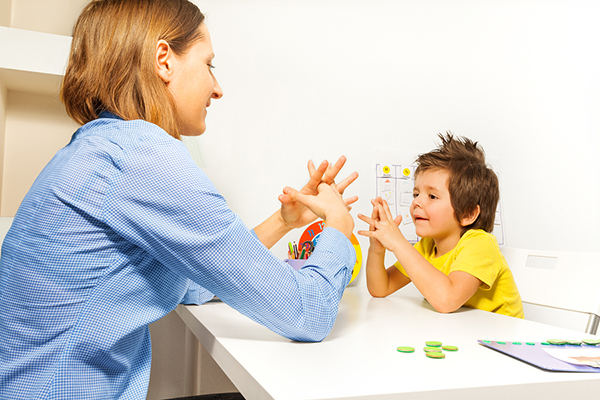
How Occupational Therapists Help Young Patients
Writing your name, buttoning a shirt, or using a fork when having a meal. Activities most of us take for granted can become quite a challenge after surgery or an injury affecting one’s arms or hands. Sometimes difficulty with certain tasks arises from a neurological or learning disorder. That’s where occupational therapy comes in.
Pediatric occupational therapists (OTs) help children and teenagers with their ability to perform activities of daily living. At Lerner Children’s Pavilion at HSS, occupational therapy patients have many different needs. Those who’ve sustained a fracture or other injury to an arm, hand, shoulder or elbow often benefit from occupational therapy on their road to recovery. OTs also help young people with cerebral palsy or another physical challenge to enhance their independence and improve their quality of life.
Doctors in the community often refer patients to the Pediatric Rehabilitation Department at HSS. Children with developmental delays or learning disorders can make significant progress when they work with an occupational therapist, according to Lorene Janowski, clinical supervisor, Pediatric Occupational Therapy. The first step is to evaluate the patient and then develop a treatment plan to meet his or her needs.
Highly Trained Professionals
Occupational therapists are highly trained professionals who obtain a Masters degree or doctorate in the field. In addition to helping patients with performing daily tasks to increase their independence, OTs work with families and caregivers. “We educate them on positioning the patient and helping him or her perform certain activities; on wheelchair use and assessment; and on using adaptive tools or assistive technology to help with everyday functioning,” Janowski explains.
Occupational therapists also help children who are having in trouble in school. “We communicate with teachers, when appropriate, to help children succeed in the classroom. We help children develop confidence so they can do well in school despite any physical, cognitive, or emotional challenges they face,” says Janowski.
Making Learning Fun
Occupational therapists have a number of tools and techniques to make learning creative and fun for their patients. They often use toys, games and props. “Playing is how children process the world and learn from it. We try to make everything as much fun as possible when we’re working on developing motor skills, coordination, balance and the way information is received and processed. We use a variety of different types of play to engage the child,” Janowski says.
Occupational therapists seek to develop a bond with their clients to help them thrive. “One of the first steps is to understand our patients: what motivates them, what energizes them. For one child, it might entail playing with trains and talking about the New York City subway system; for another, it may be dressing up as a princess,” Janowski explains. “For some, exploration and movement are therapeutic. Swings, tunnels and padded mats are provided for kids to move around and explore safely.”
The goal is for patients to transfer the skills they learn in the OT setting to the world outside. An occupational therapist may also go to the home to assess the environment and provide recommendations on adaptations to enhance a child’s quality of life.
For more information visit Pediatric Occupational Therapy at HSS.
